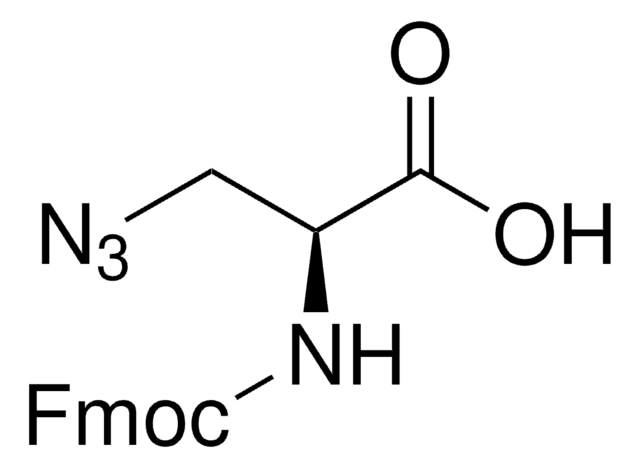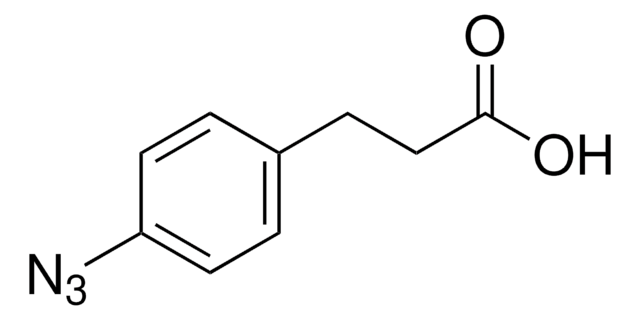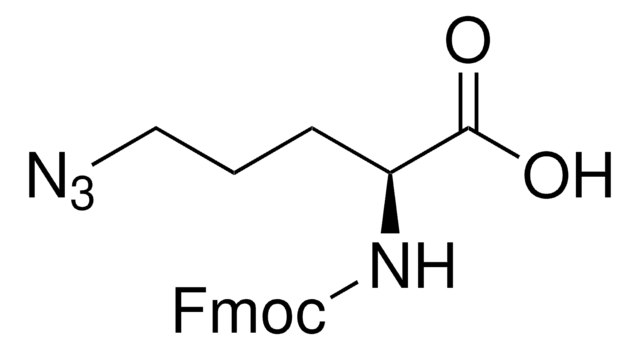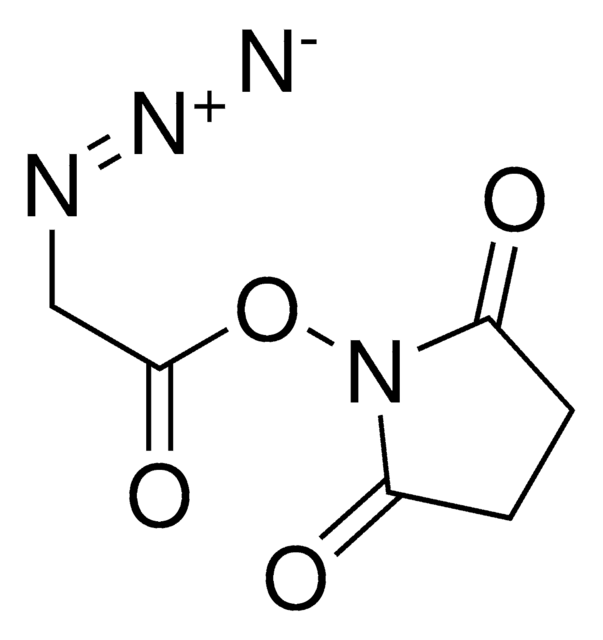712256
5-Azidopentanoic acid
≥97.0%
Synonym(s):
5-Azidovalerianic acid
Sign Into View Organizational & Contract Pricing
All Photos(1)
About This Item
Empirical Formula (Hill Notation):
C5H9N3O2
CAS Number:
Molecular Weight:
143.14
Beilstein:
1706398
MDL number:
UNSPSC Code:
12352100
PubChem Substance ID:
NACRES:
NA.22
Recommended Products
Assay
≥97.0% (TLC)
≥97.0%
97.0-103.0% (calc. on dry substance, T)
form
liquid
availability
available only in USA
loss
≤10% loss on drying
functional group
azide
carboxylic acid
storage temp.
−20°C
SMILES string
OC(=O)CCCCN=[N+]=[N-]
InChI
1S/C5H9N3O2/c6-8-7-4-2-1-3-5(9)10/h1-4H2,(H,9,10)
InChI key
SBZDIRMBQJDCLB-UHFFFAOYSA-N
Application
5-Azidopentanoic acid can be used to synthesize:
- Chitosan-poly(ethylene glycol) hydrogels by azide–alkyne click chemistry.
- 5-iodo-1,2,3-triazole containing macrocycles.
- Bivalent quinine dimers intervening triazole ring used as inhibitors of P-glycoprotein (P-gp) mediated cellular efflux.
Packaging
Bottomless glass bottle. Contents are inside inserted fused cone.
Signal Word
Danger
Hazard Statements
Precautionary Statements
Hazard Classifications
Carc. 1B - Self-react. C
Supplementary Hazards
Storage Class Code
5.2 - Organic peroxides and self-reacting hazardous materials
WGK
WGK 3
Flash Point(F)
Not applicable
Flash Point(C)
Not applicable
Personal Protective Equipment
dust mask type N95 (US), Eyeshields, Gloves
Choose from one of the most recent versions:
Already Own This Product?
Find documentation for the products that you have recently purchased in the Document Library.
Customers Also Viewed
Synthesis of 5-iodo-1, 2, 3-triazole-containing macrocycles using copper flow reactor technology.
Bogdan AR, et al.
Organic Letters, 13(15), 4060-4063 (2011)
In situ-forming robust chitosan-poly (ethylene glycol) hydrogels prepared by copper-free azide-alkyne click reaction for tissue engineering.
Truong VX, et al.
Biomaterials Science, 2(2), 167-175 (2014)
Click chemistry-derived bivalent quinine inhibitors of P-glycoprotein-mediated cellular efflux.
Kuriakose J, et al.
Bioorganic & medicinal chemistry letters, 22(13), 4410-4412 (2012)
Ian J Huggins et al.
Molecules (Basel, Switzerland), 24(18) (2019-09-13)
Nucleic Acid Therapeutics (NATs), including siRNAs and AntiSense Oligonucleotides (ASOs), have great potential to drug the undruggable genome. Targeting siRNAs and ASOs to specific cell types of interest has driven dramatic improvement in efficacy and reduction in toxicity. Indeed, conjugation
Eliška Böhmová et al.
Pharmaceutics, 12(1) (2020-01-16)
Cell-penetrating peptides (CPPs) are commonly used substances enhancing the cellular uptake of various cargoes that do not easily cross the cellular membrane. CPPs can be either covalently bound directly to the cargo or they can be attached to a transporting
Our team of scientists has experience in all areas of research including Life Science, Material Science, Chemical Synthesis, Chromatography, Analytical and many others.
Contact Technical Service












![2-[2-(2-Azidoethoxy)ethoxy]ethanol solution ~0.5 M in tert-butyl methyl ether](/deepweb/assets/sigmaaldrich/product/structures/374/007/eea7ca74-41e4-4aac-af71-c93c37ec0a5a/640/eea7ca74-41e4-4aac-af71-c93c37ec0a5a.png)
